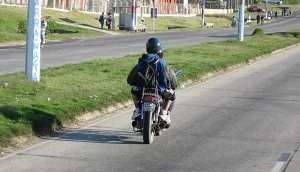Sounds of Spring–Hum of Motorcycles in Greater St. Louis

I always know it is springtime when I hear that certain sound in my neighborhood of a motorcycle engine. I welcome that sound because it means the weather is getting better. After a brutal St. Louis winter, we are all excited about the sounds, smells, and warmth of spring. The sound of motorcycles also reminds me that there are going to be more motorcycles on the roadways, and I have to be on the lookout for motorcyclists.
There are over 5 million motorcycles registered in the United States, according to the National Highway Transportation Safety Administration (NHTSA). Motorcycles are popular for many reasons, including low initial cost compared to an automobile, pleasure riding, and good fuel efficiency for some models. Motorcycle fatalities make up 5 percent of all highway fatalities, yet they represent just 2 percent of all registered vehicles.
One of the main reasons motorcyclists are killed in crashes is because the motorcycle itself provides virtually no protection in a crash. An automobile has more weight and bulk than a motorcycle. Automobiles usually have cushioning and airbags in order to soften impact and safety belts to restrain passengers. Furthermore, automobiles often have door beams and a roof to provide some measure of self-protection in an impact or rollover. Windshield wipers and washers to help with visibility and automobiles are more stable in snow and bad weather. A motorcycle suffers in comparison to an automobile when considering vehicle safety directly contributing to occupant safety.
What a motorcycle sacrifices in weight, bulk, and other crashworthy features are offset somewhat by its agility, maneuverability, ability to quickly stop, and ability to swerve quickly when necessary. When a person is considering transportation, usually they are not considering just a motorcycle or just an automobile as their primary mode of transportation. Oftentimes, in the Midwest, snow and other hazardous weather conditions make riding a motorcycle year-round almost impossible.
Some Safety Actions Motorcyclists Must Take
- Realize that you are hard to see. While motorcyclists have every right to use the roadways as any other type of driver, it is a fact that many drivers of other vehicles simply are not looking for a motorcyclist. A motorcycle can be lost in other driver’s blind spots. Also, over the winter months in Missouri and Illinois, other drivers get out of the habit of looking for motorcycles since they are so rare in the winter months. To increase your visibility on the roadways, wear brightly colored, reflective clothes. Don’t ride in the “No-Zone” or blind spots of other drivers. And anticipate other driver behaviors–easy to say, harder to do. Operate your motorcycle as though you think other drivers will NOT see you rather than assuming they will.
- Wear a Helmet. In Missouri, a helmet is required, while in Illinois, it is not always required. A helmet helps provide greater protection for the head. Studies have debunked the idea that neck injuries are more common for motorcycle riders due to helmet use or that hearing is impaired by helmets. The benefits far outweigh the negative associations of not wearing a helmet. The difference between wearing or not wearing a helmet could be the difference between living and not living in the event of a motorcycle crash.
- Know Safety and Be Licensed. Motorcycle safety courses provide opportunities for you to better your skills in a safer environment. Be sure you are properly licensed and skilled to operate the motorcycle that you are riding. Riding a motorcycle requires more skill and coordination than driving a car. An estimated 33 percent of motorcycle operators killed in traffic crashes are not licensed or are improperly licensed to operate a motorcycle. By not obtaining a motorcycle license, riders are bypassing the only method they and state agencies have to ensure they have the knowledge and skills they need to safely operate a motorcycle.
- Do Not Buy More Power Than You Need. Large motorcycles are heavy, and you must be strong enough to push it or pick it up if it falls over. Buy a motorcycle that best fits your needs. Consider the purposes of your motorcycle—are you using it to get around town, or are you planning on doing long-distance travel? Don’t buy a trail bike for highway use, and don’t buy a highway bike for trail use. Most motorcycles are built and have special characteristics for their intended purpose, including suspension and tire qualities. You need to know what kind of riding you plan on doing and use your motorcycle for that intended purpose. If you plan on using your bike for dual purposes, combination cycles are available that make a compromise between road and trail riding.
- Never Ride Without a Certified Helmet and Eye Protection. The helmet is the most important piece of safety equipment. Make sure it is comfortable and fits snugly and fastened for the ride.
- Wear the Right Shoes, Gloves, and Clothing. Thick protective clothing not only provides comfort against the elements of nature, but the protective clothing can be the only thing between you and the pavement in a crash. Studies have shown that protective clothing and equipment serve a three-fold purpose for motorcyclists: comfort and protection from the elements, some measure of injury prevention, and through the use of color or reflective material, a means for better visibility to other motorists.
- Obey All Traffic Laws. Be courteous. Some motorcycle riders are greatly offended by the operation of motorcycles by some other motorcyclists, such as weaving in and out of traffic, riding on shoulders, or risk riding. Often, motorcycle riders are some of the most safety-conscious people, so when a motorcyclist rides in a risky way, it gives a bad name to all motorcyclists. Being inconsiderate of other motorists creates a negative image for all riders.
We All Share The Road
We all share the road. Thus no individual has more rights than another because of the type of vehicle they are driving. Unfortunately, motorcycle riders assume more burden of safety than do other motorists simply because they are at a disadvantage in a collision due to exposure and size. Other drivers have an equal responsibility to be on the lookout for motorcyclists. Each of us, as a driver of any vehicle, has a responsibility to drive courteously, keep a lookout for other vehicles, not drive impaired, and obey traffic laws.
We are at the end of April and the official launch of motorcycle season in the Midwest. Drivers of all kinds of vehicles must be on the lookout for other motorists in order to avoid auto accidents. Summertime means more and more motorcyclists on the highways and roadways. When a motorcycle crash does happen, most often, it results in serious injury or death. Because of the severity of a crash, motorcyclists and all drivers must work to avoid any kind of accident. Whether you ride a motorcycle or not, you owe it to everyone else on the roadways to be a safe driver. You have a responsibility to pay attention, be alert to other motorists, and avoid distracted driving. Of course, it goes without saying–you must avoid driving while impaired, whether it is a car or a motorcycle.
Accidents happen, but when accidents happen that are preventable, they are tragic incidents. If someone makes a choice or is negligent in their driving and the result is a crash that injures another or results in a death, then that driver must take responsibility for that choice. If you have been injured in a motorcycle accident or a car accident, it is important to find out all of the factors that caused the crash in order to determine liability. Sometimes, the choices made minutes and hours before the crash contributed to the crash, such as drinking and driving.
It is likely that if you have recently been in a motorcycle accident and are injured, you will not know all of the factors involved in the crash. Investigations and accident reconstructions are critical to determining the causes as well as witness statements and investigation of the physical evidence. If you are injured or if you have lost someone in an accident, the last thing on your mind is the proper investigation process. For that reason, you hire an expert motorcycle accident attorney to handle the investigation and claim process for you while you focus on your health and family. Our attorneys at The Cagle Law Firm are available seven days a week for confidential consultations at (314) 276-1681.
Contact Us Today
The Cagle Law Firm serves accident and injury clients throughout St. Louis and the greater St. Louis metropolitan area, including the eastern Missouri and southern Illinois communities. If you or a loved one needs legal assistance with your personal injury case, call The Cagle Law Firm at (314) 276-1681 or use our online contact form to schedule a free consultation.
Areas Served
The Cagle Law Firm – Missouri
The Cagle Law Firm – Illinois
The Cagle Law Firm – Kentucky
CONTACT THE CAGLE LAW FIRM TODAY
Schedule your FREE CONSULTATION today by contacting us at (314) 276-1681 or by sending us an email through the online contact form.
Contact Us Today
Request Your Free Consultation
Fields marked with an * are required
Copyright © 2024 The Cagle Law Firm. All rights reserved.





